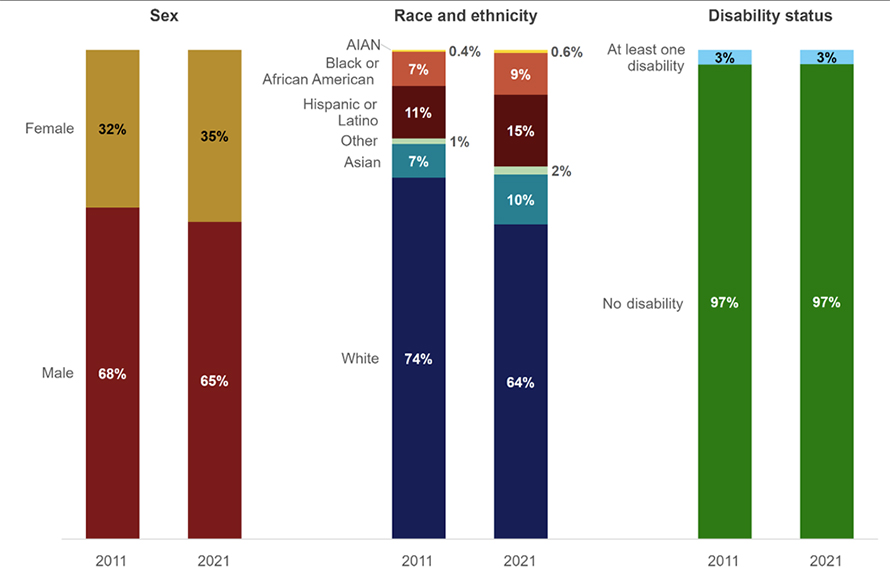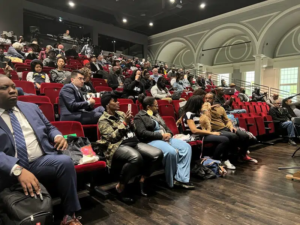This month, we saw rulings from the Supreme Court on affirmative action, student loan forgiveness and LGBTQ+ rights that set back progress on these critical issues. These rulings have me very concerned about the future state of science in the United States. Just last year, the National Science Foundation’s report “The State of U.S. Science and Engineering 2022” showed that the U.S., across multiple indices, has lost its place as the world leader in science and technology. These decisions are going to see us slip back further, I’m afraid.
Diversity in STEM benefits us all
Another fascinating set of statistics published by the NSF this year was its report on diversity in science, technology, engineering and mathematics. The report shows that there has been very little progress on increasing diversity in the STEM workforce from 2011–2021.

This is a huge problem — not just for individuals from undeserved communities, but for everyone. A tweet from former First Lady Michelle Obama, a Black woman who attended a primarily white institution, in response to the Supreme Court’s decision on affirmative action put this so eloquently: “It wasn’t just the kids of color who benefited, either. Every student who heard a perspective they might not have encountered, who had an assumption challenged, who had their minds and their hearts opened gained a lot as well.”
There is research to support the fact that diversity benefits us all. The world is now facing some of its most challenging issues, such as climate change and a pandemic, so it is important that we have a thriving STEM workforce that pushes creativity and innovation to new levels to help address these issues. Research shows that bringing diversity to the table can help. For example, in a study of 4,277 companies in Spain, companies with more women were more likely to introduce radical new innovations into the market. In another study looking at profitability across 20,000 firms in 91 countries, companies with more female executives were shown to be more profitable. There also have been studies that show racially diverse teams exchange a wider-range of information in making decisions as compared to all-White teams.
SCOTUS decisions will decrease diversity in STEM
The recent decisions from the Supreme Court will make diversifying the STEM workforce a greater challenge. Lessening opportunities for Black, Indigenous and other people of color to enter the STEM workforce is not only unethical, but it will weaken U.S. strength and leadership in science and technology. Prior research and case studies, discussed below, provide some predictability of what will happen to the U.S. scientific enterprise because of the Supreme Court’s decisions — a less diverse STEM workforce being a major takeaway from this work. Given that this body of scientific research clearly did not inform the Supreme Court’s decisions, I’m afraid we may be witnessing a disturbing trend where these lawmakers are substituting their policy preferences for legal judgments (a problem we also saw in the court’s decision on Sackett v. EPA).
Affirmative action: In the Students for Fair Admissions, Inc. v. President and Fellows of Harvard College case, the Supreme Court decided that affirmative action was not a constitutional right. Therefore, universities will no longer be able to consider race and ethnicity in admissions going forward, and in fact could be held accountable for doing so. Let’s look to a case study from California to illustrate how could this impact STEM diversity.
In 1996, California passed Proposition 209, which ended affirmative action in the state’s public universities. That proposition had huge impacts on the student makeup at public universities. The state’s most selective universities in California, UCLA and UC-Berkeley, saw nearly 40% declines in enrollment of Black and Hispanic students. The proposition also has had long-term ramifications for Black, Hispanic and Native American students in California. Researchers found that these students were less likely to get graduate degrees, and they earned about 5% less wages for 15 to 20 years than they would have earned if they had been able to take advantage of affirmative action at more selective universities. In California, there also is evidence that Proposition 209 limited workforce diversity for people of color and women statewide.
Student loan forgiveness: In another case, the Supreme Court ruled that the Biden administration’s student loan forgiveness plan is unconstitutional. This decision will further add financial stress to the most underserved individuals in the country and make it a more challenging decision for students to attend college and get STEM degrees.
According to the Education Data Initiative, student loan forgiveness would immediately increase the wealth of Black individuals in the US by 40%. Systemic racism and institutional barriers make it difficult for Black, Indigenous, and other people of color to afford college in the first place. For example, Black college attendees have an average net worth that is $8500 less than their White peers. Given that Black, Indigenous, and other people of color also bear the brunt of student loan debt, forgiveness of this debt could help narrow the racial wealth gap in the US.
LGBTQ+ discrimination: The Supreme Court also ruled last week that businesses have a right to discriminate against minorities, particularly those identifying as LGBTQ+. This comes on the heels of hundreds of other pieces of legislation pushed in the past year in the US that target and attack the LGBTQ+ community. This Supreme Court decision is another that tells people across the US that hate against the LGBTQ+ community is ok.
The Supreme Court’s decision last week, and the more than 600 legislative attacks on LGBTQ+ people, will certainly make it more challenging for such folks to successfully enter STEM fields. As I have written time and time again, the odds are stacked against LGBTQ+ folks when it comes to working on and finishing degrees in STEM fields. And even if they make it into those fields, then they must deal with the discrimination that follows. The Supreme Court decision today is just another punch to the LGBTQ+ community’s gut, which will make it more challenging to diversify the STEM workforce.
These decisions hurt underserved people the most
All these decisions impact underserved communities the most. They saddle the most undeserved individuals with more debt, put up roadblocks and barriers to getting a good education, and give a thumbs up to discrimination. None of these decisions follow the best available science and information that we have on these issues: they are decisions that were made for political purposes. Our concern level has risen at UCS because of these decisions, meaning we all need to fight harder to ensure that decisionmakers are using science when they are making decisions that affect people’s very real lives. As Justice Sotomayor understood and made clear in her dissent on the decision to restrict affirmative action in college admissions, if we don’t fight back on these decisions, inequalities will continue to persist: “Today, this court overrules decades of precedent and imposes a superficial rule of race blindness on the Nation. The devastating impact of this decision cannot be overstated. The majority’s vision of race neutrality will entrench racial segregation in higher education because racial inequality will persist so long as it is ignored.”
This article was republished with permission from the Union of Concerned Scientists. Read the original.




